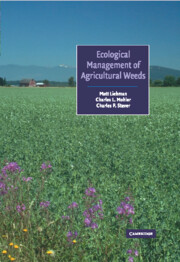Book contents
- Frontmatter
- Contents
- Preface
- 1 Weed management: a need for ecological approaches
- 2 Weed life history: identifying vulnerabilities
- 3 Knowledge, science, and practice in ecological weed management: farmer–extensionist–scientist interactions
- 4 Mechanical management of weeds
- 5 Weeds and the soil environment
- 6 Enhancing the competitive ability of crops
- 7 Crop diversification for weed management
- 8 Managing weeds with insects and pathogens
- 9 Livestock grazing for weed management
- 10 Weed evolution and community structure
- 11 Weed management: the broader context
- Taxonomic index
- Subject index
10 - Weed evolution and community structure
Published online by Cambridge University Press: 10 November 2009
- Frontmatter
- Contents
- Preface
- 1 Weed management: a need for ecological approaches
- 2 Weed life history: identifying vulnerabilities
- 3 Knowledge, science, and practice in ecological weed management: farmer–extensionist–scientist interactions
- 4 Mechanical management of weeds
- 5 Weeds and the soil environment
- 6 Enhancing the competitive ability of crops
- 7 Crop diversification for weed management
- 8 Managing weeds with insects and pathogens
- 9 Livestock grazing for weed management
- 10 Weed evolution and community structure
- 11 Weed management: the broader context
- Taxonomic index
- Subject index
Summary
Introduction
Most weed management practices are motivated by short-term goals: reduction of weed impact on the current crop and prevention of seed production that could pose problems in succeeding crops. A slightly longer perspective may enter considerations of crop rotation and its impact on weeds (see Chapter 7), but weed management planning horizons of farmers rarely exceed five years. In contrast, important phenomena relating to weed diversity, community composition, and weed evolution affect weed communities on time scales of five years to centuries. In principle, these processes could be managed, though at present they largely are not. This chapter explains why long-term management of these phenomena may be needed, and outlines some tentative strategies.
The nature of long-term changes in weed species and communities has not been well documented and proposals for managing these changes are therefore necessarily speculative. Consequently, most of this chapter focuses on the ecological and evolutionary processes governing the changing nature of weed species and communities, with most suggestions for management reserved for the final sections. Three general points will be made.
First, evolutionary and community responses of the earth's flora to the resources available in farm fields leads to a continuous increase in the global diversity of agricultural weeds. Simultaneously, long-distance colonization events and local spread of species to new locations create a tendency toward increase in regional and local weed diversity.
- Type
- Chapter
- Information
- Ecological Management of Agricultural Weeds , pp. 444 - 493Publisher: Cambridge University PressPrint publication year: 2001
- 6
- Cited by



